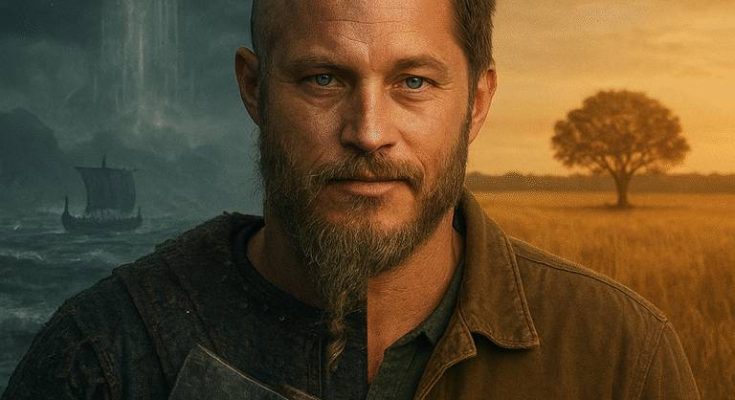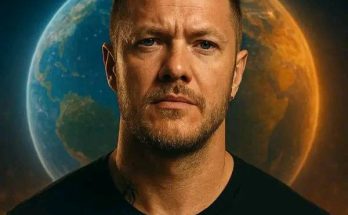“Beyond the Shores of Valhalla: The Real-Life Journey of Travis Fimmel” is a story that stretches far beyond the glimmering runes of Viking legends and the cinematic appeal of television screens. While most audiences first came to know Travis Fimmel as the stoic, battle-hardened Ragnar Lothbrok in the historical epic Vikings, the journey that brought him to that iconic role—and the life he has led since—is a tale of resilience, reinvention, and an almost uncanny defiance of the ordinary. Fimmel’s story is not simply a biography of an actor; it is the narrative of a man who has navigated the sometimes turbulent waters of fame, artistic integrity, and personal evolution, emerging at each stage with a sense of quiet determination that seems almost as legendary as the Norse heroes he portrays.
Born in 1979 in Echuca, Victoria, Australia, Travis Fimmel grew up in a small town along the Murray River, an environment that offered both freedom and formative challenges. Life in Echuca, a place defined by wide skies and the ebbing waters of the river, instilled in him a grounded perspective and a rugged resilience. These qualities would later inform his performances on screen, giving his characters a sense of authenticity that resonates far beyond scripted lines. Fimmel was not immediately destined for acting, nor did he follow a conventional path toward celebrity. His early life was more about physical pursuits, exploration, and testing boundaries than about Hollywood dreams. Sports, outdoor adventures, and a restless curiosity defined his formative years, and these experiences instilled a discipline that would later serve him in the rigorous demands of modeling, acting, and film production.
Fimmel’s first step into the limelight was unexpected and, in many ways, accidental. He was discovered as a model in his late teens, his striking features and intense presence catching the attention of agents in Melbourne. The world of high-fashion modeling, while glamorous, was a foreign realm for a young man from a small Australian town. Fimmel quickly ascended in the modeling world, landing campaigns for globally recognized brands. His ability to command attention with a single glance, to embody a presence without words, made him a natural fit for photography and the runway. Yet, despite success in modeling, there was an underlying restlessness, a sense that this path was merely a prelude to something more substantial. Modeling brought visibility and financial stability, but it did not fully satisfy the creative and personal aspirations that were quietly building within him.
The transition from modeling to acting was neither immediate nor easy. Fimmel’s early acting roles were modest, often supporting parts in Australian television and film. He approached acting with a seriousness that belied his relatively limited experience, dedicating himself to studying the craft and learning the subtleties of emotional expression. Unlike modeling, where a single image could communicate an entire mood, acting required depth, narrative understanding, and the ability to inhabit a character fully. Fimmel’s commitment to mastering this new medium paid off when he caught the attention of casting directors in the United States. This led to his first major international exposure in Hollywood, a world that was simultaneously intimidating and intoxicating. Hollywood offered both opportunity and challenge, a landscape filled with promise yet fraught with pitfalls that could easily derail an unprepared actor. Fimmel’s approach, however, remained methodical and deliberate. He embraced each role as a learning experience, using every performance to refine his skills and explore the layers of human emotion.
The defining moment in Travis Fimmel’s career, the role that would transform him from a rising actor into an international phenomenon, was his casting as Ragnar Lothbrok in Vikings. The character of Ragnar is steeped in legend, a Norse hero whose exploits straddle myth and historical speculation. Portraying such a figure required not only physical presence but an emotional resonance capable of capturing the complexities of ambition, loyalty, and human frailty. Fimmel approached the role with an almost reverential dedication, immersing himself in historical research, physical training, and character development. His performance was noted for its authenticity, the kind of nuanced portrayal that makes viewers forget they are watching an actor at all. Through Ragnar, Fimmel became synonymous with a certain intensity and charisma, a quality that reverberated far beyond the Viking sagas and into popular culture. Yet, despite the fame and acclaim, Fimmel’s relationship with stardom was never conventional. He has often expressed a preference for solitude and reflection, valuing personal integrity over public adulation, a stance that sets him apart in an industry where visibility is often equated with success.
The years following Vikings saw Fimmel navigating the delicate balance between professional growth and personal authenticity. Rather than being typecast by his iconic role, he sought diverse characters that challenged him and expanded his range as an actor. His performances in films such as Warcraft, where he portrayed the stoic and noble Anduin Lothar, and The Baytown Outlaws, where he embodied a more rebellious and morally ambiguous figure, showcased his versatility. Each role allowed him to explore different facets of storytelling, from epic fantasy to gritty action, highlighting his ability to inhabit both the mythic and the mundane with equal credibility. Fimmel’s choices reflect a deliberate intention to avoid complacency, a refusal to be defined solely by past successes. In this way, his career is not just a series of performances but a continuous journey of self-discovery, a narrative of growth that mirrors the personal evolution he has undergone since his earliest days in Echuca.
Beyond his professional achievements, Travis Fimmel’s life off-screen has been equally compelling. He has cultivated a reputation for privacy, eschewing the constant scrutiny that often accompanies celebrity status. This discretion is not merely a matter of avoidance but an intentional act of preserving a sense of self amid the pressures of public life. Fimmel’s personal pursuits, from art and music to adventure and exploration, provide a counterbalance to the intensity of his acting career. His time spent in nature, traveling, and engaging in physically demanding activities reflects a deep-seated desire to remain connected to the elemental forces of life—forces that echo the rugged landscapes and primal conflicts depicted in his most famous roles. This connection to the natural world informs both his craft and his character, lending a grounded authenticity to his performances that is rare in an industry often dominated by artifice.
Travis Fimmel’s journey also speaks to the broader themes of resilience and transformation. His career trajectory—from small-town Australia to international fame, from modeling to acting, from supporting roles to cultural icon—illustrates the importance of adaptability and persistence. At each stage, he has demonstrated an ability to confront challenges without losing sight of his values. Fame, often intoxicating and destabilizing, has not diminished his commitment to personal growth or artistic integrity. Instead, it has provided a platform for exploring deeper questions about identity, creativity, and purpose. Fimmel’s life embodies the paradox of the modern celebrity: the capacity to influence and inspire a global audience while maintaining a fiercely private and introspective inner life. This balance, delicate and often precarious, is a testament to his discipline, self-awareness, and unwavering commitment to authenticity.
Moreover, Fimmel’s journey is marked by a certain humility and groundedness that contrasts sharply with the grandiosity of his on-screen personas. While he portrays heroes and antiheroes with epic gravitas, his personal ethos remains rooted in simplicity and sincerity. He is known for valuing meaningful human connections over superficial recognition, for prioritizing experiences and growth over accolades. This perspective is evident in interviews, public appearances, and personal anecdotes, all of which reveal a man more interested in substance than spectacle. Fimmel’s story, in this regard, resonates as a modern myth—a narrative of a hero who navigates trials not only in battle or performance but in the very act of living fully and authentically.
As Travis Fimmel continues to evolve, both as an actor and as an individual, his journey offers insights into the interplay between destiny and choice, fame and anonymity, myth and reality. He remains a figure who defies easy categorization, a man whose life story is as compelling as any character he has portrayed. His trajectory underscores the idea that true achievement lies not merely in external recognition but in the consistent pursuit of personal excellence and authenticity. In a world that often celebrates spectacle over substance, Fimmel’s approach serves as a reminder of the enduring value of integrity, dedication, and the quiet courage to chart one’s own course.
In reflecting on the real-life journey of Travis Fimmel, one sees a narrative that is both inspirational and instructive. It is a story that celebrates talent, yes, but more importantly, it celebrates the human qualities that sustain that talent: perseverance, self-reflection, and an unwavering commitment to personal truth. From the quiet streets of Echuca to the global stages of film and television, Fimmel’s life exemplifies a path forged through intention, effort, and an instinctive understanding of one’s own worth. His story reminds us that beyond the glories of performance and the allure of fame lies a more profound journey—a journey that, like the sagas of old, is defined by courage, resilience, and the relentless pursuit of meaning. “Beyond the Shores of Valhalla” is not merely a tale of an actor’s rise to prominence; it is the chronicle of a man who has navigated the intersections of legend and reality with grace, intelligence, and an unshakable sense of self. It is a story that continues to unfold, inviting audiences not only to witness the evolution of an extraordinary performer but also to reflect on the timeless quest for purpose, identity, and authenticity that resides within us all.



